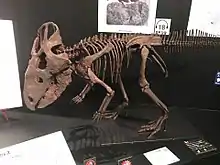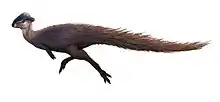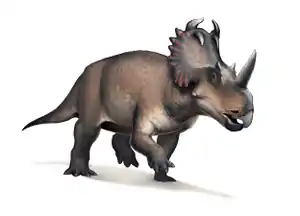Cerasinops
Cerasinops (meaning 'cherry face') was a small ceratopsian dinosaur. It lived during the Campanian of the late Cretaceous Period.[1] Its fossils have been found in Two Medicine Formation, in Montana. The type species of the genus Cerasinops is C. hodgskissi.

| Cerasinops Temporal range: Late Cretaceous, | |
|---|---|
 | |
| Scientific classification | |
| Domain: | Eukaryota |
| Kingdom: | Animalia |
| Phylum: | Chordata |
| Clade: | Dinosauria |
| Clade: | †Ornithischia |
| Suborder: | †Ceratopsia |
| Family: | †Leptoceratopsidae |
| Genus: | †Cerasinops Chinnery & Horner, 2007 |
| Species: | †C. hodgskissi |
| Binomial name | |
| †Cerasinops hodgskissi Chinnery & Horner, 2007 | |
Cerasinops was named and described by Brenda Chinnery and Jack Horner in 2007 from a specimen (MOR 300) almost 80% complete, indicating a total body length of 2.5 m (8.2 ft) and a body mass of 175 kg (386 lb).[2] It belonged to the Ceratopsia (the name is Ancient Greek for 'horned face'), a group of herbivorous dinosaurs with parrot-like beaks that throve in North America and Asia during the Cretaceous Period. Within this group, it has been placed as a basal member of Neoceratopia, although the description is variable; at one point, it is explicitly assigned to Leptoceratopsidae, but in others, it is considered a sister taxon to Leptoceratopsidae, or as a neoceratopsian in general.[3]
See also
References
- "Missing Link" Dinosaur Discovered in Montana, a National Geographic article; the photographed skeleton is actually from Montanoceratops.
- Paul, Gregory S. (2016). The Princeton Field Guide to Dinosaurs. Princeton University Press. p. 278. ISBN 978-1-78684-190-2. OCLC 985402380.
- Chinnery, Brenda J.; Horner, John R. (2007). "A new neoceratopsian dinosaur linking North American and Asian taxa". Journal of Vertebrate Paleontology. 27 (3): 625–641. doi:10.1671/0272-4634(2007)27[625:ANNDLN]2.0.CO;2.

.png.webp)


